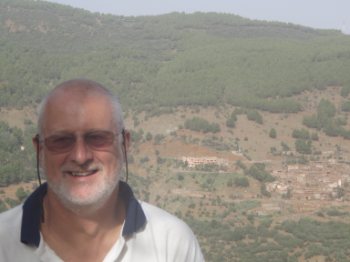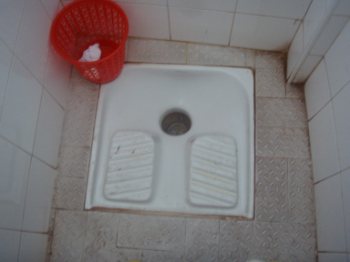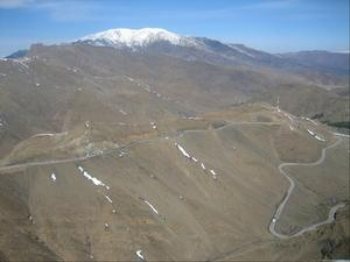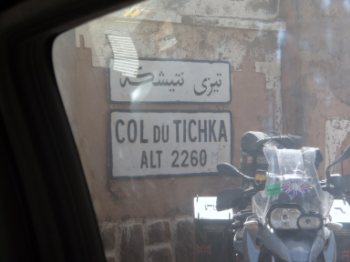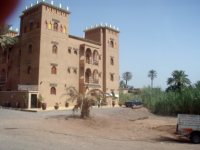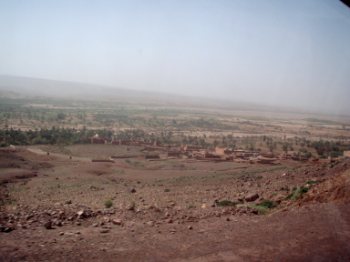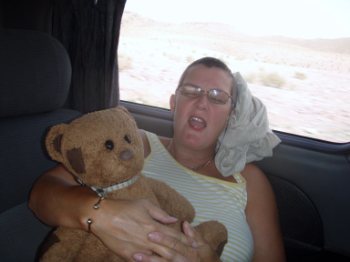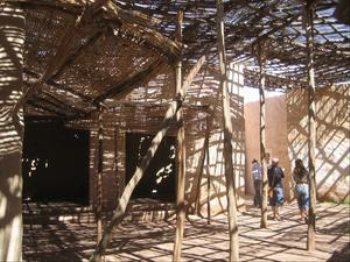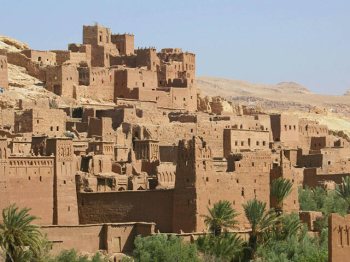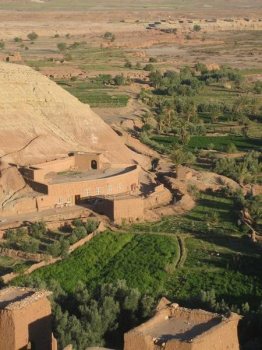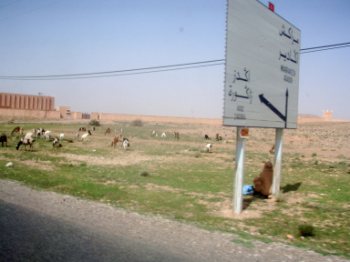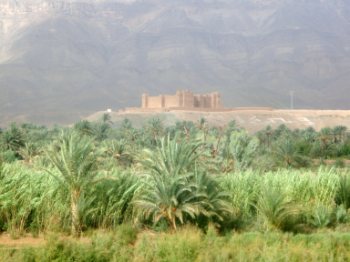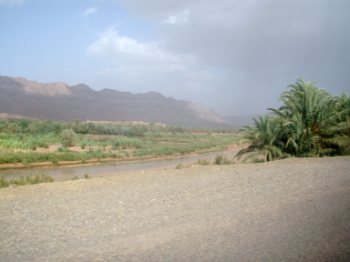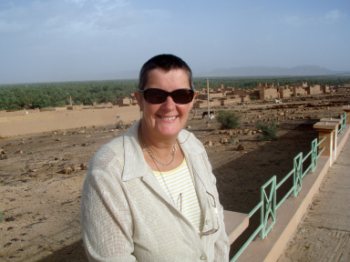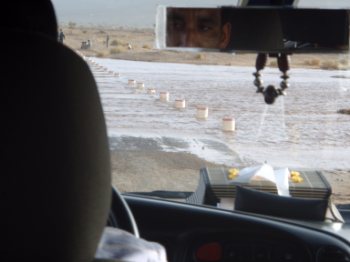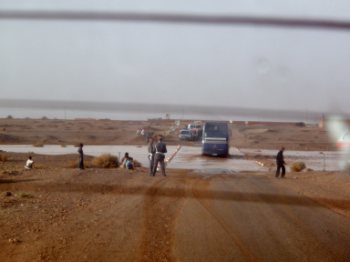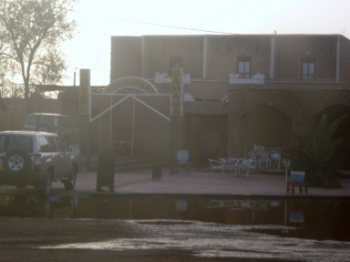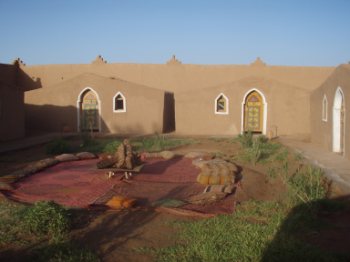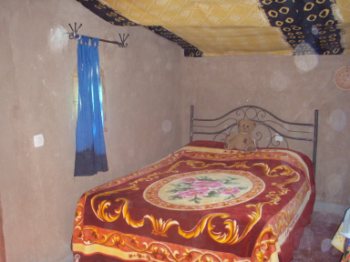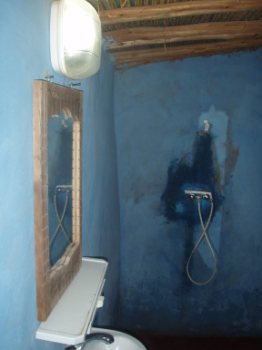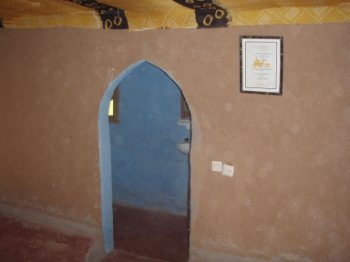M'Hamid Day Two

|
Day Two MARRAKECH
to M'HAMID
We were met at the Riad Le Plein Sud at 08:00 for the first leg of our Saharan Trek. The views changed from the oak forests and walnut groves of the Marrakech plains, giving way to rocky cliffs and steep drops as the road climbed into the mountains.
Moroccan map showing to Ouarzazate our lunch stop and Zagora. Bear with the first hill village we saw on our journey.
The valley below, the first time we have ever seen someone matching her outfit to her hair. Our first "starting block" toilet experience in Morocco. The Atlas Mountains (Kabyle: Idurar n leṭles, Arabic: جبال الأطلس ) is a mountain range across a northern stretch of Africa extending about 2,400 km (1,500 miles) through Morocco, Algeria, and Tunisia. The highest peak is Jbel Toubkal, with an elevation of 4,167 meters (13,671 ft) in southwestern Morocco. The second highest mountain is the Megon of 4,071 meters (13,356 ft). The Atlas ranges separate the Mediterranean and Atlantic coastlines from the Sahara Desert. The population of the Atlas Mountains are mainly Berber tribes in Morocco and kabyles in Algeria. The terms for 'mountain' in some Berber languages are adrar and adras, believed to be cognate with the toponym. The mountains are divided into additional and separate ranges, including the Middle Atlas, High Atlas, and Anti-Atlas. The lower Tell Atlas running near the coast and the larger Saharan Atlas running further south terminate in the Aures Mountains located in Algeria and Tunisia. The Atlas Mountains constitute one of the distinct physiographic provinces of the larger African Alpine System division. Sharp drops, hair pin turns, mud slides, rock slides, road vendors rushing at the mini bus to sell. In winter snow and ice or heavy rain fall make the journey one of breathtaking scenery and variety.
The hairpin bends, a mountain village, remote and basic but with satellite dishes !!! and the height marker on the Tizi-n-Tichka Pass. Ouarzazate (Arabic, ورزازات, Warzāzāt) (called The door of the desert), is a city in southern Morocco. Its name comes from a Berber phrase meaning "without noise" or "without confusion". It is also featured by its closeness to the Atlas Mountains and the Draa Valley. This was our lunch stop.
Some photos taken in Ouarzazate ( pronounced waar za zate ) Bear's Tagine of chicken lunch, I had Spaghetti Bolognese as I thought it would be a good liner for what may follow ???
The valley and the flatter landscape beyond. Sammy our driver put on Elton John singing Sacrifice, I had to sing along. ECLA Film Studios. ECLA Studios, known as the Hollywood of Morocco, this is where numerous blockbuster movies have been shot including; Lawrence of Arabia (1962); The Man Who Would Be King (1975); Jesus of Nazareth (1977); The Jewel of the Nile (1985); The Living Daylights (1987); The Last Temptation of Christ (1988); The Sheltering Sky (1990); Kundun (1997) Cleopatra (1999); The Mummy (1999), Alexander (2004) and as well as some scenes for Star Wars and Gladiator (2000). You can visit these legendary film studios.
Scene for the movie The Kingdom, Cleopatra and the slave market used in Gladiator.
Aït Benhaddou (Arabic: آيت بن حدّو) is a 'fortified city', or ksar, along the former caravan route between the Sahara and Marrakech in present-day Morocco. It is situated in Souss-Massa-Draa on a hill along the Ouarzazate River and has some beautiful examples of kasbahs, which unfortunately get damaged each rainstorm. Most of the town's inhabitants now live in a more modern village at the other side of the river; ten families however still live within the ksar. Aït Benhaddou is a UNESCO World Heritage Site since 1987.
Ait Benhaddou, the arena used in Gladiator, herd of goats with the owner leaning up against the road sign, film studios to the left.
Zagora with its lush date groves, very fertile in and around the river.
For a laugh I told Sammy our driver that I would drive for a while if he wanted me to, to give him a rest. Shortly after the rains came, and did it rain, just like when it was my turn to drive at home. Very quickly the low lying road became flooded.
Eventually, 500 kilometers of journey later, we arrived to a very warm welcome at The Hotel Sahara, M'Hamid, a former French Foreign Legion Barracks, on the northern edge of the Sahara, the last village/oasis in the Draa Valley. After supper, tagine of chicken, bread and salad, we joined two American ladies, Mina and her aunt Suzanne (right), who had become the first woman to own property in Morocco, she intends to build a Riad to cater for the top end tourist. After a really great fun jam session, singing and dancing, helped along with date fire-water ( not unlike Saki ) we got to bed at 02:00, our room on the right called Dakar.
Inside our room, complete with full en-suite.
HAPPY BIRTHDAY MARK All in all an exhausting, exciting and colourful day.
|

